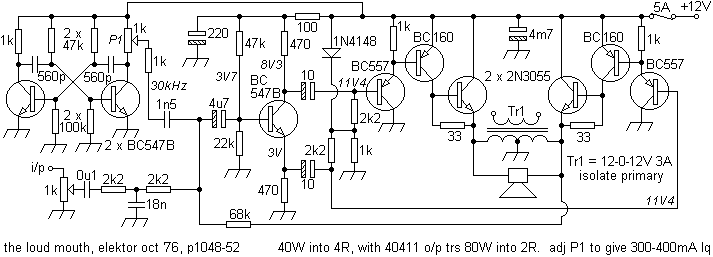
'Loudmouth' Class C 12V power amplifierAlthough not intended for 'hi-fi' applications this portable design was capable of pulling a fair punch with excellent intelligibility for speech applications and music.

To reduce crossover distortion, an HF astable running at 30kHz helped to average and thus fill-in the transition period. To maximise power output, the speaker was fed by two output stages, each anti-phase to the other and a transformer winding across the output was used to give a back EMF 'kick' of 24V across the load. Efficiency at maximum output is about 55%.If, for higher outputs, 40411 (90V, 30A, 150W, 800kHz, hFE 35-100) output transistors were not available, other 30A types like the 2N3772 could be used instead. Upgrading the transformer secondary is also recommended. Compare to Class D operation.
These were used very successfully with a homebrew LM381 mixer/preamp and a Technics SL-10 driving a quantity of various speaker types including a Bessell array, sometimes in the remotest of sites, the author being attracted by the limitations set by battery supplies. For safety, fuse to suit load. An automotive bulb can be ideal.
Some Aussies report "...this amplifier did indeed have lots of distortion but for drunken bachelor’s parties in the bush this worked a treat. The transformer used was one from a battery charger, I used identical components and it took about two hours to put together. A really classic design but more importantly – the zaniest circuit I have ever come across. Well pertaining to that time of course… In those days bridging car amps were the order of the day – maximum rating was about 20W per channel. To be honest at low input levels I could hear the cross switching distortion but as one turned the volume up it became less noticeable. The first real test was indeed at a bachelor’s party and it did outperform the car amplifiers of the day in terms of power. The more drunk we got the better it sounded, especially when listening to Uriah Heap at full tilt. Possibly the most fun we ever had from an amplifier. It was eventually sold off. The circuit scientists recommended dropping the load impedance and putting in higher power transistors – this could also be done by the paralleling of the output 2N3055s and upgrading the driver transistors. I never tried that though. The fact that the transistors were biased to off was overcome by driving them with a 30KHz square wave. Ingenious."
Rafael Benitez, another user/constructor, writes "Ben Duncan, in his 'High Performance Audio Power Amplifiers for music performance and reproduction' (p84), states that 'Class C is used for RF. It is inapplicable to audio'. While in agrement with much that he has written I can say, Ben you are so so wrong."
Contact me at paulkemble@hotmail.com
especially if you want additional content to this page
or if you find any links that don't work. Don't forget
to add the page title or URL. Take care!
Back to index, sound, tips or home.